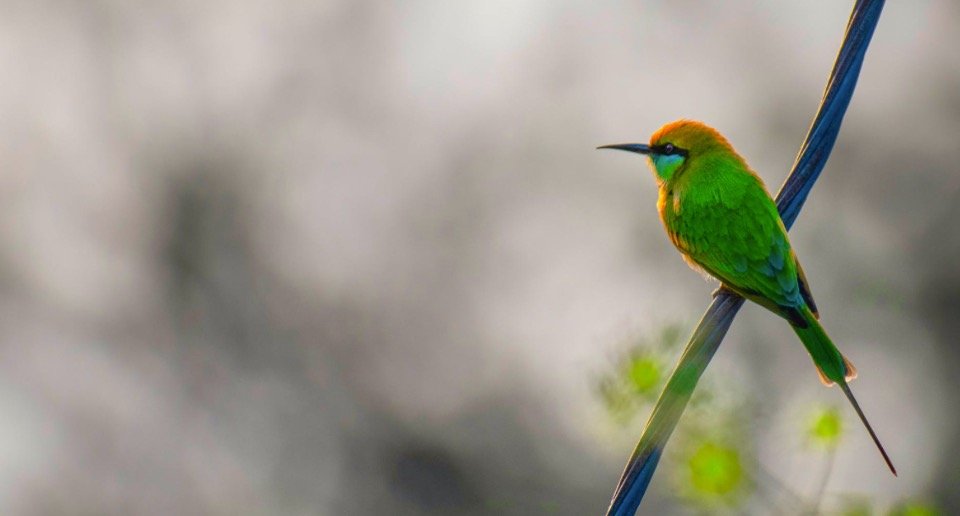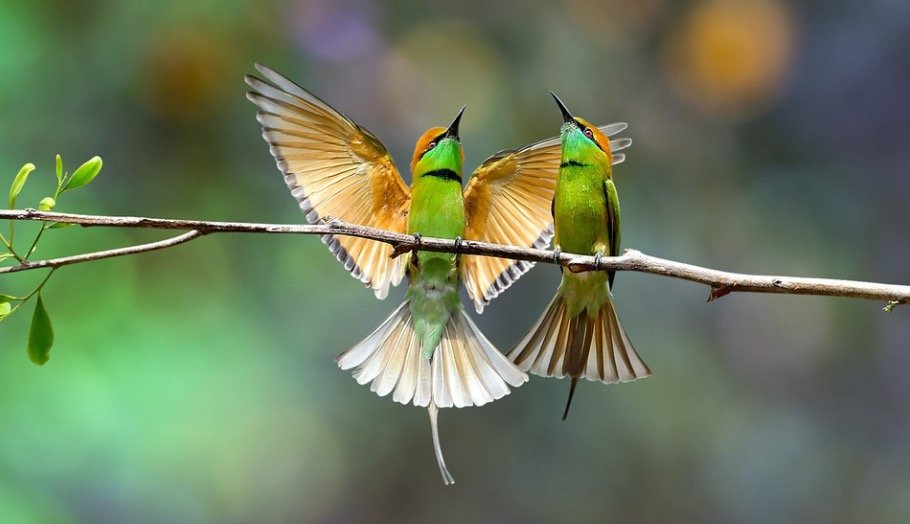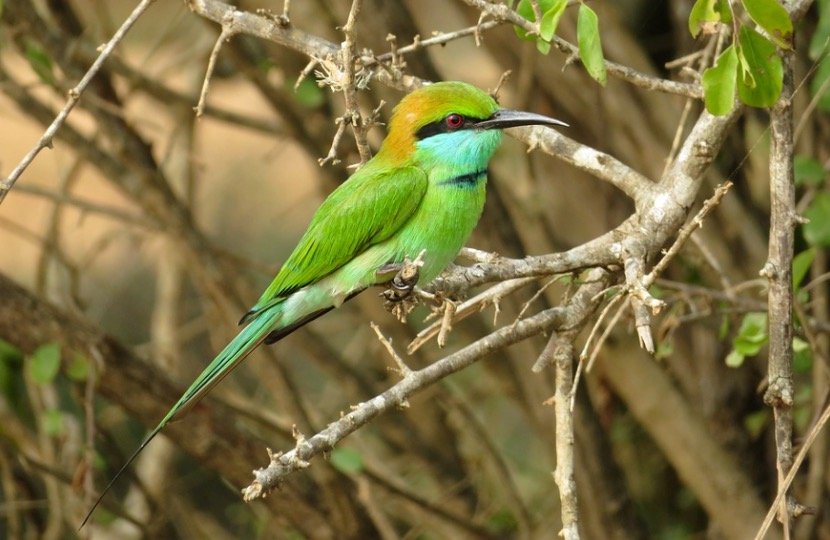
A green bee-eater (Merops orientalis) is an omnivorous creature belonging to the Animalia family, phylum Chordata, class Aves, order Coraciiformes, and family Meropidae. Its genus is Merops. Its height is up to 6.2 to 7 inches, it weighs up to 0.5 to 0.7 ounces, and it has a wingspan of up to 11.4 to 19.3 inches, with a lifetime of up to 12 to 18 years.
A green bee-eater is a bird that feeds on honey-bees, bees, and flying insects. The long curved beak and bright green plumage are the most distinguishing characteristics. Green bee-eaters are preyed upon by eagles, storks, and raptors.
Physical features include brown, yellow, blue, black, white, green, and orange skin colorations, and feathers on the skin, with a top speed of 26 mph.
Green Bee-Eater Description
The green bee-eater, sometimes known as the little green bee-eater, is one of the smallest bee-eater species. It is regarded as one of the most attractive birds due to its small size, distinct call, slender body, and colourful plumage.
Do Birds Pee? Everything You Need To Know
It may be found in a wide range of woody locations in Sub-Saharan Africa, western Arabia, and eastern Asia. Although it is not on the verge of disappearing, its native habitat as well as populations of its major prey, honeybees, are declining.

From Mauritania to central China, green bee-eaters may be found in a variety of habitats, including the Nile River and the Himalayas. Greece, Senegal, Gambia, Egypt, Iran, India, Pakistan, Nepal, Bhutan, Afghanistan, Bangladesh, Cambodia, Thailand, Laos, Myanmar, and Vietnam are among the other nations.
Forest, grassland, and sparse scrub make up its habitat. Arid habitats, plains, savannahs, scrub, grasslands, open woods, fields, and farmlands in Africa and Asia are the ideal places to look for green bee-eaters. In urban and suburban areas, they can even be spotted perched atop television antennas.
Can Ducks Fly? (All You Need To Know)
They also make seasonal visits to Pakistan, where they establish riverfront habitats in southern India or high altitude habitats in the Himalayas. The gregarious birds normally sleep in groups of 20 and dust-bathe in groups of 30.
Keep in mind that they roost in trees and make a distinct sound. Green bee-eaters usually lay their eggs in May or June. Their nests are dug into the hollows of sandbanks or mud banks by both sexes, who make tunnels or burrows up to 5 feet long and 2-3 feet deep (1-2m).
Tunnels are dug through level land or mild slopes in Africa, whereas low coasts are excavated in Asia. The females lay 3-8 eggs in a 15cm (5.9-in) long hole on the naked ground at the end of the tunnel. Green bee-eaters live in a wide range of habitats and do not move.
Despite the fact that their colourful plumage and tiny stature attract many larger predators, they engage in predator avoidance behaviour when predators approach their nests. Their precise numbers have not been determined, despite the fact that they have 26 species, habitats in numerous countries, and are rated as “least concern” by the IUCN.
What Is The State Bird Of Arkansas?
The African green bee-eater, Asian green bee-eater, and Arabian green bee-eater populations, on the other hand, are growing.

Amazing Green Bee-Eater Facts
• Honeybees make over 80% of their food, as their name suggests.
• It does not move. However, it does migrate seasonally owing to rainfall.
• The green bee-eater is a bee-killer by nature.
• It exhibits predator avoidance behaviour as well as “theory of mind” consciousness, something humans and other primates do not have.

Green Bee-Eater Species
Green bee-eaters are divided into 26 subspecies. Merops orientalis is its scientific name. Meropidae is a bee-eater family with three genera, one of which is the enormous Merops.
Green Bee-Eater Appearance and Behaviour
The small green bee-eater is around 9 inches (16-19 cm) length, with 2 inches of long tail feathers in the centre. It measures 29-49cm (11.4-19.3in) in length and weighs 15-25g. The predominant hue is bright emerald green, but depending on the area, some species have some red, yellow, blue, or purple coloration.
There are also leucistic individuals with variants such as a red crown and a vivid blue throat. Based on plumage traits, Merops leschenaulti is a related species, with Merops orientalis ferrugeiceps being the most comparable subspecies.
Moreover, the chin and throat are usually blue, with golden rufous on the head and back. It has rufous and green flying feathers. It features a long, slightly curved black bill that ends in a sharp tip, a narrow black stripe on its throat called a “forget,” a black mask over its crimson eyes, and two long, narrow black tail streamers in the centre.
Do Owls Eat Snakes? Everything You Need To Know
It has dark grey legs and three toes on its feeble feet. In comparison, the juvenile’s hues are drab. It lacks the large tail feathers that adults have. The female is similar to the male in appearance and size, but has a duller throat, a narrower half-collar, and shorter tail streamers.
The green bee-eater bathes in the sand more than other bee-eater species and dips its wings in the water when flying. Its sound is quiet, pleasant, nasal. tree-tree-tree-tree-tree-tree-tree-tree-tree-tree-tree-tree-tree-tree-tree-tree-tree-tree-tree-tree-tre.
When returning to its perch to swallow its meal, it is elegant and makes a zig-zag movement. It is most active throughout the day, beginning to hunt about 7:00 or 8:00 a.m. and returning around 4:00 p.m.

Green Bee-Eater Diet
The green bee-eater eats a largely insectivorous omnivorous diet. Honeybees make up about 80% of the food of the green bee-eater. Other bee species, wasps, ants, flies, butterflies, moths, dragonflies, beetles, and other flying insects make up the balance of the population.
It eats termites, caterpillars, and spiders, as well as fruits and berries, as well as ground-dwelling insects like termites, caterpillars, and spiders. It avoids grasshoppers, locusts, crickets, katydids, and wetas, which belong to the Orthoptera order.

Green Bee-Eater Predators, Threats and Conservation Status
The green bee-eater features a unique predator-avoidance behaviour during which it refuses to enter its nest if a predator is nearby. This understanding of a predator’s mental state demonstrates a “theory of mind,” which is normally exclusively shared by primates.
The green bee-eater is listed as “Least Concern” by the IUCN, but it is still susceptible to habitat degradation and the reduction of its major food source, bees. Larger birds, as well as smaller reptiles and animals, feed on green bee-eaters and their eggs.
The endoparasitic nematode (Torquatoides balanocephala) can cause gizzard infections in them. They’ve been known to urge a protozoal parasite in their blood in India (Haemoproteus manwelli).

Green Bee-Eater Reproduction, Babies and Lifespan
The mating season for green bee-eaters is from March to June or July to August. At present, incubation is predominantly done by the female, despite the fact that both sexes collaborate.
Do Birds Eat Spiders? Everything You Need To Know
They are monogamous and have lifelong partners. They are solitary nesters with assistance, which also includes juvenile and adult young, throughout Africa and Asia. They establish tiny colonies in India, with bigger colonies ranging from 10 to 30 breeding pairs in Myanmar and Pakistan.
Both parents provide food to the chicks, who stay in the nest for 22 to 31 days. Birds are born with the capacity to destroy bees, so they don’t need to be taught how to deal with stinging insects. In the wild, the bird has a lifetime of 12–18 years.





